Search the Special Collections and Archives Portal
Search Results
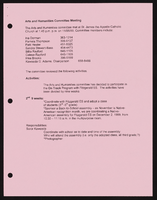
Alpha Kappa Alpha Sorority, Theta Theta Omega Chapter arts and humanities committee report
Date
Archival Collection
Description
From the Alpha Kappa Alpha Sorority, Incorporated, Theta Theta Omega Chapter Records (MS-01014) -- Chapter records file.
Text
Gertrude and Roosevelt Toston Photograph Collection
Identifier
Abstract
The Gertrude and Roosevelt Toston Photograph Collection is comprised of digital surrogates of photographic prints, slides, and ephemera documenting Gertrude and Roosevelt Toston's lives in Las Vegas, Nevada from 1958 to 2002. The collection mainly documents Roosevelt Toston's career as a newscaster for KLAS-TV and Gertrude Toston's involvement with the Delta Sigma Theta Sorority. Other images in this collection include photographs of Roosevelt Toston's childhood home in Epps, Louisiana and photographs of Gertrude Toston with her stepfather, Reverend Leo A. Johnson.
Archival Collection
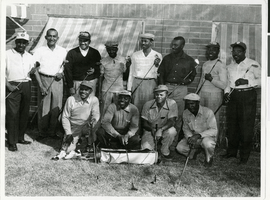
Photograph of Valley View Golf Club members at the Las Vegas Municipal Golf Course in 1958
Date
Archival Collection
Description
Local African American golfing enthusiasts gather for group photo at Las Vegas Municipal Golf Course in 1958. Annotation: "Valley View Golf Club 1958". Stamped "Photo by Dick Kanellis, Las Vegas Sun, Las Vegas, Nevada".
Image
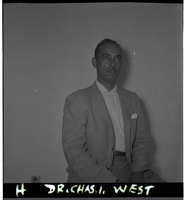
Film negative portraits of Dr. Charles I. West, May 20, 1955
Date
Description
Series of three black and white negative portraits of Moulin Rouge physician, Dr. Charles I. West, dated May 20, 1955.
Image
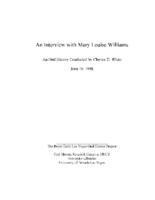
Transcript of interview with Mary Louise Williams by Claytee D. White, June 19, 1998
Date
Archival Collection
Description
Interview with Mary Louise Williams conducted by Claytee D. White on June 19, 1998. Born in Cleveland, Ohio, Williams was musically trained and worked as a dancer at the opening of the Moulin Rouge in 1955. Following her career in social work and teaching in New York, she retired to Las Vegas.
Text
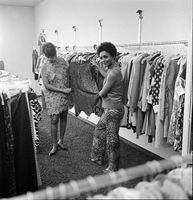
Set of photographs including Claudine and Arthur Wade wedding, Alpha Kappa Alphas at Barbara Kirkland's, Bee at Continental, Boyd's birthday party, girls at Saraan's shop, and Alpha Kappa Alphas at SNV
Date
Archival Collection
Description
Photographer's notations: Wedd. Claudine & Arthur Wade, AKA's at Barbara Kirklands, Bee at Continental, Boyd's Birthday party, Girls at Saraann's shop, AKAs at SNV.
Image
Audio clip from interview with Samuel Smith, June 17, 2011
Date
Archival Collection
Description
Part of an interview with Samuel Smith, June 22, 2011. In this clip, Smith speaks about his run-in with Las Vegas police when he moved to the area, and the relationship between police officers and the black community.
Sound
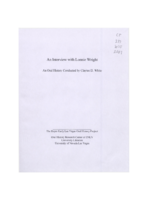
Transcript of interview with Lonnie G. Wright by Claytee D. White, October 23, 2009
Date
Archival Collection
Description
Interview with Lonnie G. Wright conducted by Claytee D. White on October 23, 2009. Wright played basketball at UNLV and became a successful local educator and businessman. His grandmother worked as a maid for prominent Las Vegans.
Text

Transcript of interview with Samuel and Sherrill Coleman by Claytee White, February 12, 2016 and February 22, 2016
Date
Archival Collection
Description
Sherrill and Samuel Coleman moved to Las Vegas during the 1990s after both enjoying a full life and numerous careers in other parts of the United States. They met each other through church in 1998 and married each other in April 1999. Now retired, both Samuel and Sherrill remain active in their church community. Samuel Coleman was born in Durant, Mississippi in 1928 to a sharecropping family. His father died when he was 13 months old, leaving his mother to raise seven children by herself. Over time, his family slowly migrated to Chicago and he joined them when he was 15. For eight months, Samuel worked a number of different jobs until he began to work for Burlington Railroad as a four cook. The United States Army drafted him in 1951 and sent him overseas to work in a motor pool for a military hospital in Korea, despite his status as a conscientious objector. At war’s end, he returned to work for Burlington. During his last 17 years with the railroad, Samuel successfully petitioned to join the Brotherhood of Sleeping Car Porters, the union for railroad cooks, porters, and waiters, to improve the working and sleeping conditions at Burlington Railroad. He retired from the railroads in the 1970s and chose to pursue other careers. Until his official retirement in 1993, Samuel worked in real estate, as the owner of a liquor store, a firefighter, a restaurant inspector, and a deacon for his church. His daughter from his first wife moved to Vegas to pursue a career as a teacher and after a number of visits, Samuel decided to follow her in 1999. Sherrill Coleman was born in Newton, Kansas in 1941. Like many other African American women in her community, she worked as a housekeeper for a number of years. She and her first husband moved to Los Angeles County in 1964 where she took a temporary job in the elections department of the local government. In 1967, Sherrill became a file clerk for Los Angeles County’s Department of Public Social Services. By the time she left the department, she was middle management in the auditing department. She moved to Vegas in 1993.
Text
Clarence Ray oral history interview
Identifier
Abstract
Oral history interview with Clarence Ray conducted by Eleanor L. Walker in 1991 for the African American in Las Vegas: a Collaborative Oral History Project. In this interview, Ray provides details of his ancestry and upbringing, his education, and race relations in the western United States before 1930. He then moves on to his first visit to Las Vegas, Nevada in 1922, and his movements before settling permanently in the 1940s. He explains that the main source of employment for the relatively small Black population during the 1920s and early 1930s was the railroad, but a number were also in business. Mr. Ray provides thumbnail sketches of many of the early residents, and is particularly informative about "Mammy" Pinkston, Mary Nettles, the Stevens family, and the Ensley family. Systemic racial discrimination against Blacks developed in southern Nevada during the 1930s, and Mr. Ray provides some useful details on this along with his discussion of his career in gaming and his social and political activities.
Archival Collection
